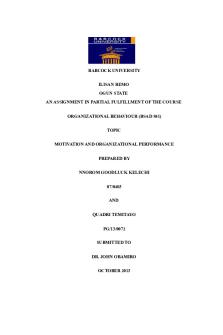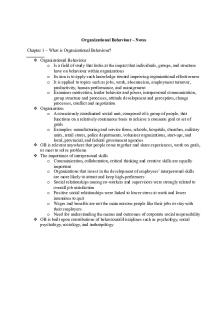Organizational Behaviour and Analysis 3 - Personality PDF

| Title | Organizational Behaviour and Analysis 3 - Personality |
|---|---|
| Author | John Smith |
| Course | ORGANISATIONAL BEHAVIOUR AND ANALYSIS |
| Institution | University of Surrey |
| Pages | 9 |
| File Size | 658.6 KB |
| File Type | |
| Total Downloads | 100 |
| Total Views | 133 |
Summary
Download Organizational Behaviour and Analysis 3 - Personality PDF
Description
Organizational Behaviour Analysis 3 (Sem. 2, Yr. 1)
Organisational Behaviour and Analysis 3 – Personality Objectives 1. What is Personality? 2. Nomothetic vs Idiographic Approach 3. Personality Theories 4. Personality and Satisfaction 5. Personality and Performance
1. What is Personality? The dynamic organisation within the individual of those psychophysical systems that determine his unique adjustments to his environment” – Allport • Considered to be the result of both hereditary factors and environmental Organisational Relevance • Important as research has shown personality tests are useful for hiring and picking workers for tasks • of individuals’ performance and productivity is a key issue for most organizations • Have to find the right FIT: • Personality is key to understanding individual differences Person-Job Fit (PJF) • • •
Personality-Job fit theory – John Holland 6 personality types – how well matched these types are to job roles correlates with job satisfaction Higher congruity between personality and job fit = higher satisfaction
1
Organizational Behaviour Analysis 3 (Sem. 2, Yr. 1)
Person-Organization Fit (POF) Important for employees for moving around the company in different roles and environments • Geert Hofstede – managers and employees vary on five value dimensions of national culture: o Power Distance ▪ Degree to which people in a country accept that power in institutions and organizations is distributed unequally. High rating on power mean large inequalities of power/wealth exist and are accepted, discouraging upwards mobility. Low scores mean cultures that stress equality o Individualism vs Collectivism ▪ Individualism – degree at which people like to work by themselves ▪ Collectivism – like being in groups, looking after eachother o Masculinity vs Femininity ▪ How much culture favors traditional masculine roles (achievement, power and control) a high rating here means that there is differing roles with masculinity dominating ▪ High femininity mean little differentiation between male and female roles o Uncertainty Avoidance ▪ Degree to which structured/unstructured situations are preferred, high scores mean higher levels of anxiety about uncertainty o Long-Term vs Short-Term Orientation ▪ Level of devotion to traditional values, long term looks to the future short term focusses on the present Despite being well regarded by organizational behavior researchers, the theory is criticized because he only interviewed employees from one company (IBM) and over 30 years old now •
Model of Individual Differences Growing workforce diversity requires managers to view individual differences in a fresh new way, to understand and accommodate employee diversity Some of the most important dimensions of individual differences: •
1. 2. 3. 4. 5. •
•
Self-concept and self-management, Personality traits, Attitudes, Mental abilities Emotions. The below figure is a conceptual model showing the relationship between selfconcept (how you view yourself), personality (how you appear to others), and key forms of self-expression. Considered an integrated package, these factors provide a foundation for better understanding yourself and others as unique and special individuals.
2
Organizational Behaviour Analysis 3 (Sem. 2, Yr. 1)
Personality is: • Enduring characteristics unique to individual • Personality refers to the whole person and includes: o Intelligence o Motivation o Emotion o Learning o Cognition o Social interactions • These can be revealed by interaction with environments: Personal / interpersonal / organizational • Some are easier to measure than others
2. Nomothetic vs Idiographic Approach – 2 basic scientific approaches Idiographic approach •
• • • • • • • • •
Based on the uniqueness of the individual. Rejects the notion that we can all be measured on the same dimensions o Cooley - ‘Looking glass self’ – we are a mirror of the people with whom we interact. Phenomenological bias Individualizes: richness of the individual Intensive study of individuals Describes personality in terms of self-identity Personality seen as an intelligible whole Personality determined by social/cultural processes Personality is adaptable and open to change Popular in second half in 20th century You can't really change who you inanely are
Nomothetic approach •
• • • • • • • • •
Emphasizes the identification of personality traits, looks for systematic relationships between different aspects of personality. o Eysenck - Extraversion-introversion / Neuroticism-stability. o Costa & McCrae - Advocated Big 5 (conscientiousness, agreeableness, neuroticism, openness, extroversion) Positivist bias Generalizes: laws of human behaviour Statistical study of groups Describes personality in terms of traits/types Personality seen as discrete elements Personality determined by heredity/biology/genetics Personality is given at birth and cannot be altered Popular 1st half of 20th century You can change
3
Organizational Behaviour Analysis 3 (Sem. 2, Yr. 1)
3. Psychodynamic Personality Theories (Idiographic) Freud’s psychoanalysis - 3 components of personality: •
Id:
o stuff you're born with, biological element, unconscious, demands gratification of pleasure-seeking drives, left uncontrolled, world would be bad • Superego: o learned values & demands of culture and society; can be made partially conscious • Ego: o developed in childhood; can be made conscious; controls behaviour to reconcile demands of id, superego and the outside world Jung (1965) • Can't put people into boxes, but can create characteristics to help define people • Sensing o Awareness of things and processes through the senses • Thinking o Understands what a thing is and puts a name to what is sensed • Feeling o Reacts to things emotionally and deems the acceptable or unacceptable • Intuition o Has hunches about past/future events in the absence of evidence
4. Type and Trait Personality Theories (Nomothematic Sheldon (1942) • Personality associated with one of three body shapes – “somatotypes”. • Somatotype – temperament related to physique o Ectomorph ▪ Physique: thin, delicate ▪ Type: restrained, inhibited, introverted, artistic, intellectual o Mesomorph ▪ Physique: muscular, strong, rectangular ▪ Type: energetic, physical, adventurous, assertive o Endomorph ▪ Physique: overweight, soft, round ▪ Type: sociable, relaxed, easy-going, enjoys food • TWO problems: o People do not easily fit into these rigid descriptions o Appearances do not correspond to personality traits (e.g., a mesomorph may be unassertive and adventurous – they just go to the gym a lot!) 4
Organizational Behaviour Analysis 3 (Sem. 2, Yr. 1)
Allport (1961) • Considered to be a founding figure in personality theory • He identified several thousand words that described human traits, and he theorized that these words could be organized into 3 groups of traits: o Cardinal: dominant trait that influences behavior ▪ e.g., Determination, Greed, Obsession, etc. o Central: characteristics found in every individual ▪ Intelligence, compassion, honesty, integrity, etc. o Secondary: limited, may escape notice in some situations ▪ Do not really characterize an individual Cattell (1965) *EXAM* • Surface traits o Observable o Positively correlated clusters of variables ▪ e.g. ▪ Disciplined Foolish ▪ Thoughtful Unreflective ▪ Austere
Profligate • Source traits o Foundation of all other traits o Affect the observable pattern of behaviour • 16 personality factors: Eysenck 1975 - Personality Dimensions: This assumes people fit into one box and don't mix and match
Why is this important? • “Today, psychometric testing (i.e., personality, ability, and aptitude testing) is seen as a key factor in the recruitment process for many leading organisations, as it offers an alternative means of assessing and qualifying candidates to the more traditional CV and interview methods.” www.milkround.com (20th September 2011) • “… the value of psychometric tests sold every year to UK organisations is more than £20 million, and that in 2003 they were used in most of the public sector and for selection in more than … 85% of the FTSE 100. In the United States, it is suggested that the value of sales of psychometric tests and inventories for recruitment, team and personal development is in excess of 100 million US dollars per year.” Harper (2008) 5
Organizational Behaviour Analysis 3 (Sem. 2, Yr. 1)
The Big Five Five ‘super traits’ (Costa and McRea, 1992) OCEAN: Theory that 5 basic dimensions underlie all others and encompasses most of the significant variations in human personality. Successful in predicting how people behave in real life situations • Openness o Openness to experience, fascination with novelty; Fantasy, aesthetics, feelings, actions, ideas, values • Conscientiousness o Measure of reliability: Competence, dutifulness, achievement, striving selfdiscipline, deliberation • Extraversion o Comfort level with relationships. Extroverts possess warmth, gregariousness, assertiveness, activity, excitement-seeking, positive emotions • Agreeableness o How likely people are to agree/rely on others: Trust, straightforwardness, altruism, compliance, modesty, tender-mindedness • Neuroticism/emotional stability o Ability to withstand stress: Worry, anger, discouragement, selfconsciousness, impulsiveness, vulnerability Research has shown relations to these and job performance – see reading… Myers-Briggs Type Indicator • Most widely used personality assessment istrument in the world • People are classified by the following: o Extroverted (E) (outgoing, sociable, assertive) or Introverted (I) (quiet, shy) o Sensing (S) (practical, routine and order) or intuitive (N)(unconscious processes and look at the big picture) o Thinking (T) (reason and logic to handle problems) or feeling (F) (rely on personal values and emotions) o Judging (J) (want control, order and structured) or perceiving (P) (flexible and spontaneous) • These classifications together describe 16 personality types, identifying every person by one train from each of the four pairs. o E.g. Introverted, intuitive, thinking and judging (INTJ) = visionaries with great drive o ESTJ = organisers o ENTP = innovative and conceptual
6
Organizational Behaviour Analysis 3 (Sem. 2, Yr. 1)
Assumptions of Type Theory • Indicator measures preferences – over and under exaggeration cancels each other out • Preferences are not absolute • Preferences are not abilities • No right type • People themselves are the best judges of their type … MBTI is an indicator not a test • Many people don't like this as it forces people into one type of another when there is a lot more relativity at play than this MBTI in Organizations • Communication • Conflict • Problem-solving & decision making • Teams • Leadership • Analysing organisations • Used by apple, armed forces and many other big companies
7
Organizational Behaviour Analysis 3 (Sem. 2, Yr. 1)
Emotional Intelligence • Salovey & Mayer (1990) popularised by Goleman 1995 1. Appraising & expressing emotions in the self & others 2. Regulating emotion in self & others 3. Using emotions adaptively to achieve ones goals Predicting Job Performance • Identify and measure social and emotional competencies o o o o o
Bar-On’s EQ-I (Baron, 1997) (self-report) Multifactor emotional intelligence scale (Mayer, Caruso & Salovey, 1998) (ability) Emotional Competence Inventory (360 degree) EQ map (Orioli, Jones, & Trocki, 1999) Schutte, Malouff,Hall, Haggerty, Cooper, Golden & Dornheim, 1998)(33 item selfreport)
A Framework for Emotional Competencies
Emerging Issues • Emotional labour • Emotional intelligence • Diversity • Leadership potential • Ability testing • Individual characteristics and transformation of the organisational context
8
Organizational Behaviour Analysis 3 (Sem. 2, Yr. 1)
5. Personality and Satisfaction •
A key factor of personality is Locus of control (Spector, 1997) o Externals ▪ Life controlled by outside forces ▪ Prone to persuasion ▪ Lower levels job satisfaction o Internals ▪ Life controlled by the self ▪ Self-confident ▪ Higher levels of job satisfaction
•
Positive/negative affectivity (Agho et al, 1992) o Positive ▪ Disposition to be happy and content ▪ Higher levels of job satisfaction o Negative ▪ Disposition towards negative emotions ▪ Anxiety ▪ Depression ▪ Lower levels of job satisfaction
6. Personality and Performance • •
•
Many different personality/psychometric tests are employed to predict job-related performance There are mixed views regarding the extent to which these tests predict performance –> does personality predict performance??? o Example: Furnham (1992) found personality could predict driver safety. Tests were used in the selection of South African bus drivers. Accident rate reduced. He found that extroverts (i.e., people that were found to be more ‘lively’, ‘impulsive’, and ‘sensation-seeking’) who were also emotionally unstable (i.e., people that were found to suffer from anxieties, were tense and often overreacted) were more likely to be involved in bus accidents. His findings help to reduce the accident rate of South African bus drivers. Personality testing can suffer from certain weaknesses: o Little agreement on how to define or measure personality o Personality may develop/change over time o Behaviour can be context dependent (i.e., priming, headaches, boredom, etc.) o Data is typically self-reported, so insight and honesty may vary from person to person o Tests may overlook other important behavioural characteristics (e.g., absenteeism, lateness, sickness) o Can lead back to stereotyping and the failure to appreciate the more subtle and/or complex aspects of an individual’s personality 9...
Similar Free PDFs
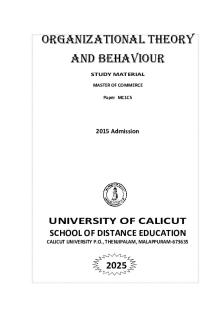
Organizational theory and behaviour
- 186 Pages
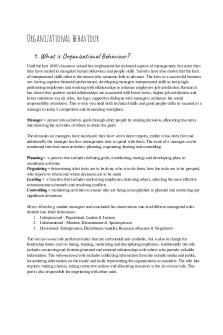
Organizational behaviour
- 67 Pages

Organizational Behaviour
- 2 Pages
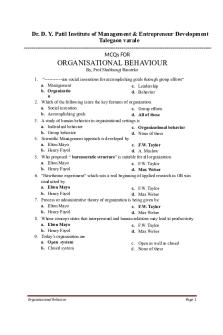
Organizational Behaviour mcqs
- 27 Pages
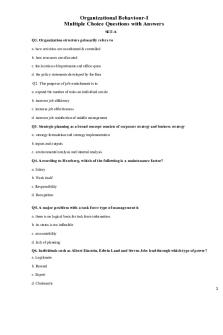
Organizational Behaviour MCQ SET
- 20 Pages
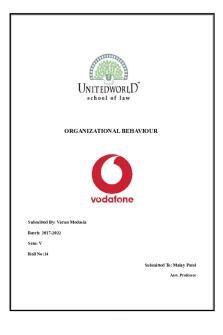
Organizational Behaviour Project
- 15 Pages

Chapter 2 ORGANIZATIONAL BEHAVIOUR
- 23 Pages

Organizational Behaviour Glossary
- 17 Pages
Popular Institutions
- Tinajero National High School - Annex
- Politeknik Caltex Riau
- Yokohama City University
- SGT University
- University of Al-Qadisiyah
- Divine Word College of Vigan
- Techniek College Rotterdam
- Universidade de Santiago
- Universiti Teknologi MARA Cawangan Johor Kampus Pasir Gudang
- Poltekkes Kemenkes Yogyakarta
- Baguio City National High School
- Colegio san marcos
- preparatoria uno
- Centro de Bachillerato Tecnológico Industrial y de Servicios No. 107
- Dalian Maritime University
- Quang Trung Secondary School
- Colegio Tecnológico en Informática
- Corporación Regional de Educación Superior
- Grupo CEDVA
- Dar Al Uloom University
- Centro de Estudios Preuniversitarios de la Universidad Nacional de Ingeniería
- 上智大学
- Aakash International School, Nuna Majara
- San Felipe Neri Catholic School
- Kang Chiao International School - New Taipei City
- Misamis Occidental National High School
- Institución Educativa Escuela Normal Juan Ladrilleros
- Kolehiyo ng Pantukan
- Batanes State College
- Instituto Continental
- Sekolah Menengah Kejuruan Kesehatan Kaltara (Tarakan)
- Colegio de La Inmaculada Concepcion - Cebu



